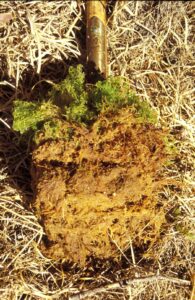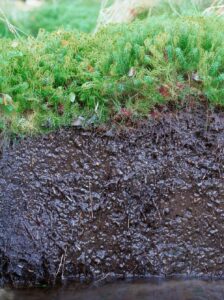Hn
A H horizon of the topsoil with current peat formation from the dead remains of peat-forming mosses and peat-forming higher plants. In the fluctuating area of bog, stagnant water or groundwater and temporary overflow. The organic matter consists of extremely low to completely humified plant remains [n from new].
- organic carbon content ≥ 15 mass % and
- formed from the remains of peat-forming plants.
- Saturated with water all year to predominantly saturated or flooded and
- formed under predominantly anaerobic and only very briefly aerobic conditions and
- peat formation through incomplete decomposition of plant remains and
- dense elastic network of living, aerial plant roots or basal sections of mosses and
- no segregation structure and
- current vegetation dominated by peat-forming plants.
Modified Hn horizons
Hfn
A modified Hn horizon, peat-forming horizon, permanently waterlogged or flooded, predominantly anaerobic with very weak aerobic conditions due to aerial roots or water table fluctuations; very clearly recognisable plant structures in the extremely low or moderately humified peat [f from fibrum, fibre].
- organic carbon content ≥ 15 mass % and
- formed from the remains of peat-forming plants.
- Saturated with water all year to predominantly saturated or flooded and
- formed under predominantly anaerobic and only very briefly aerobic conditions and
- peat formation through incomplete decomposition of plant remains and
- dense elastic network of living, aerial plant roots or basal sections of mosses and
- no segregation structure and
- current vegetation dominated by peat-forming plants.
- degree of humification according to von Post H1 – H4
Hfn-horizon, extinct spagnum moss, low grade of humification, humus form: Dystric F-Moor, ©Gerhard Milbert
Hen
A modified Hn horizon, peat-forming horizon, seasonally waterlogged or flooded, predominantly anaerobic with seasonally weakly aerobic conditions due to aerial roots and water table fluctuations; weakly to indistinctly recognisable plant structures in medium to highly humified peat [e from hemic].
- organic carbon content ≥ 15 mass % and
- formed from the remains of peat-forming plants.
- Saturated with water all year to predominantly saturated or flooded and
- formed under predominantly anaerobic and only very briefly aerobic conditions and
- peat formation through incomplete decomposition of plant remains and
- dense elastic network of living, aerial plant roots or basal sections of mosses and
- no segregation structure and
- current vegetation dominated by peat-forming plants.
- degree of humification according to von Post H5 – H7
Hhn
A modified Hn horizon, peat formation horizon, predominantly water-saturated or flooded during the course of the year, with intermittent aerobic conditions due to aerial roots and water level fluctuations or aeration; very indistinct or no longer recognisable plant structures in very highly or completely humified peat [h from completely humified = sapric].
- organic carbon content ≥ 15 mass % and
- formed from the remains of peat-forming plants.
- Saturated with water all year to predominantly saturated or flooded and
- formed under predominantly anaerobic and only very briefly aerobic conditions and
- peat formation through incomplete decomposition of plant remains and
- dense elastic network of living, aerial plant roots or basal sections of mosses and
- no segregation structure and
- current vegetation dominated by peat-forming plants.
- degree of humification according to von Post H8 – H10


